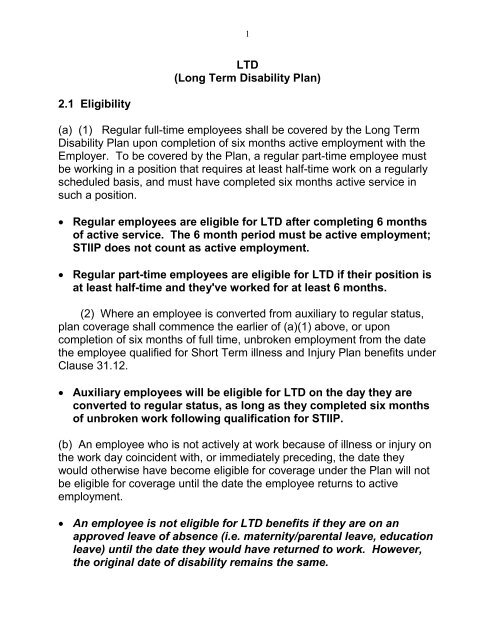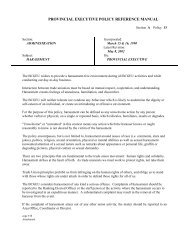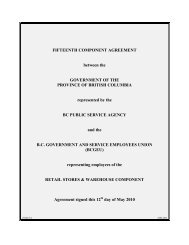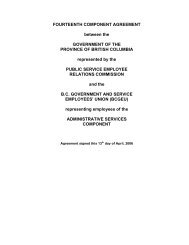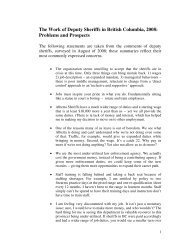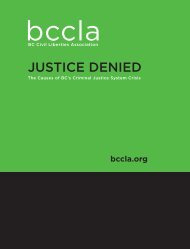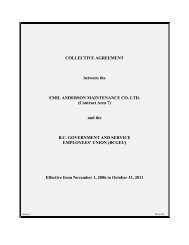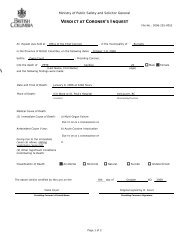Long Term Disability Plan - BC Government and Service Employees ...
Long Term Disability Plan - BC Government and Service Employees ...
Long Term Disability Plan - BC Government and Service Employees ...
You also want an ePaper? Increase the reach of your titles
YUMPU automatically turns print PDFs into web optimized ePapers that Google loves.
1LTD(<strong>Long</strong> <strong>Term</strong> <strong>Disability</strong> <strong>Plan</strong>)2.1 Eligibility(a) (1) Regular full-time employees shall be covered by the <strong>Long</strong> <strong>Term</strong><strong>Disability</strong> <strong>Plan</strong> upon completion of six months active employment with theEmployer. To be covered by the <strong>Plan</strong>, a regular part-time employee mustbe working in a position that requires at least half-time work on a regularlyscheduled basis, <strong>and</strong> must have completed six months active service insuch a position.• Regular employees are eligible for LTD after completing 6 monthsof active service. The 6 month period must be active employment;STIIP does not count as active employment.• Regular part-time employees are eligible for LTD if their position isat least half-time <strong>and</strong> they've worked for at least 6 months.(2) Where an employee is converted from auxiliary to regular status,plan coverage shall commence the earlier of (a)(1) above, or uponcompletion of six months of full time, unbroken employment from the datethe employee qualified for Short <strong>Term</strong> illness <strong>and</strong> Injury <strong>Plan</strong> benefits underClause 31.12.• Auxiliary employees will be eligible for LTD on the day they areconverted to regular status, as long as they completed six monthsof unbroken work following qualification for STIIP.(b) An employee who is not actively at work because of illness or injury onthe work day coincident with, or immediately preceding, the date theywould otherwise have become eligible for coverage under the <strong>Plan</strong> will notbe eligible for coverage until the date the employee returns to activeemployment.• An employee is not eligible for LTD benefits if they are on anapproved leave of absence (i.e. maternity/parental leave, educationleave) until the date they would have returned to work. However,the original date of disability remains the same.
2(c) Coverage in the plan is a condition of employment.• The LTD plan is m<strong>and</strong>atory for all employees that meet theeligibility requirements.• Acceptance to LTD is not automatic; there is an adjudicationprocess by an independent insurance carrier.• The current insurance carrier is the Great West Life/Canada LifeAssurance Company.• LTD runs concurrently with Worksafe <strong>BC</strong> claims; you must still gothrough the LTD application process when you are on an activeWS<strong>BC</strong> claim.2.2 <strong>Long</strong> <strong>Term</strong> <strong>Disability</strong> BenefitIn the event an employee, while covered under this plan, becomes totallydisabled as a result of an accident or a sickness, then, after the employeehas been totally disabled for six months, including periods approved inSections 1.3(a) <strong>and</strong> (c), they shall be eligible to receive a monthly benefitas follows:(a) While the employee has a sick bank balance to be used on a day-todaybasis, full monthly earnings will continue until the sick bank isexhausted, <strong>and</strong> Section 2.6 will not apply.• Over 25 years ago, there was a different sick leave plan in place<strong>and</strong> unused days were saved in a sick bank. Very few people havesick leave banks left to draw from anymore, but if you do, you mustexhaust it first.(b) When an employee has no sick bank, or after it is exhausted, theemployee shall receive a monthly benefit equal to the sum of:(1) 70% of the first $2,300.00 of monthly earnings; <strong>and</strong>(2) 50% of the monthly earnings above $2,300.00.
3For the purpose of the above, earnings shall mean basic monthly earningsas at the date of disability as determined by the Employer.The basic monthly earnings as at the date of disability shall be the salary ineffect for the last month of the Short <strong>Term</strong> <strong>Plan</strong> period, or equivalent sixmonthperiod, taking into consideration any retroactive adjustments. Thedate of disability for determining the commencement of the first 25 monthsof disability shall be the day following the last month of the Short <strong>Term</strong> planperiod, or an equivalent six-month period.• For the purpose of calculating the LTD wage loss benefit, thesalary level is frozen at the end of STIIP.(c) The <strong>Long</strong> <strong>Term</strong> <strong>Disability</strong> benefit payment will be made as long as anemployee remains totally disabled in accordance with Section 2.3, <strong>and</strong> willcease on the date the employee recovers, or at the end of the month inwhich the employee reaches age 65, or resigns or dies, whichever occursfirst.• LTD will continue, as long as the claimant satisfies the definition ofdisability, until they recover, resign, die, or until the end of themonth they reach age 65.(d) An employee in receipt of long term disability benefits will beconsidered an employee for purposes of pension benefits <strong>and</strong> will continueto be covered by group life, extended health, dental <strong>and</strong> medical plans.<strong>Employees</strong> will not be covered by any other portion of a collectiveagreement but will retain the right of access to a Rehabilitation Committeeestablished there under <strong>and</strong> will retain seniority rights should they return toemployment within nine months following cessation of benefits. Atemporary assignment or auxiliary appointment will not disqualify anemployee from the nine month access period.• LTD claimants will continue to be covered by the medical, dental,extended health <strong>and</strong> group life insurance plans. Additionally, theywill continue to accrue seniority for the purpose of their Public<strong>Service</strong> Pension <strong>Plan</strong>.• Other than Appendix 4, no other portion of the contract applies,including: vacation accrual, shift premiums, special leaves.
4However, if there is a dispute over the administration orinterpretation of Appendix 4, the grievance procedure will stillapply.• If an LTD claim ends with no return to work, seniority remainsintact for 9 months You can request an Additional 9 monthsConsideration Before the Rehabilitation Committee, without LTDwage loss benefits, for job search purposes only.• During the 9 month period, temporary assignments of work orauxiliary appointments will be allowed <strong>and</strong> the search for avacancy will continue.(e) When an employee is in receipt of the benefit described in (b) above,contributions required for benefit plans in (d) above <strong>and</strong> contributions forsuperannuation will be waived by the Employer.• Premiums for benefits are continued <strong>and</strong> contributions for pensionare waived, once accepted on an LTD claim.(f) An employee engaged rehabilitation employment with the Employer <strong>and</strong>who is receiving partial <strong>Long</strong> <strong>Term</strong> <strong>Disability</strong> benefit payments will havecontributions required for benefit plans in (d) above <strong>and</strong> contributions forsuperannuation waived by the Employer, except that superannuationcontributions shall be deducted from any salary received from the Employerto cover the period of rehabilitative employment.• Statutory deductions apply; when you return to work on a rehabtrial, contributions to your pension will be pro-rated for hoursworked.2.3 Total <strong>Disability</strong>(a) Total disability, as used in this <strong>Plan</strong>, means the complete inabilitybecause of an accident or sickness of a covered employee to perform allthe duties of their own occupation for the first 25 months of disability exceptwhere accommodation has been made which enables an employee towork:
5(1) in their own occupation;(2) in a job other than their own occupation.Where accommodation has been made which enables an employee toreturn to work they will not be considered totally disabled <strong>and</strong> the rate ofpay shall be the rate for the job.• If the Employer is unable to accommodate your medicalrestrictions, you should be eligible for LTD for a 25 month period,called "totally disabled from own occupation."If the rate of pay for this job is less than the rate of pay of the employee atthe date of disability, the employee's salary will be protected in accordancewith Clause 27.7(a) at the employee's basic rate at the date of disability.• In some circumstances, salary protection applies. If you are placedin a job with less salary than your original job, you may be eligibleto receive an additional top up to your pay.After the first 25 months of total disability, where accommodation has beenmade that enables an employee to return to a job other than their ownoccupation, the employee will not be considered totally disabled <strong>and</strong> theirbasic rate shall be the basic rate for the job or 75% of the basic rate of theirown occupation, whichever is greater.• Salary protection does not apply to claimants beyond the 25 monthLTD period. However, if placement is made into a vacancy that islower than 75% of the current rate of your old job, you will receivethe 75% salary rate of your old job.After the first 25 months of total disability, employees able by reason ofeducation, training or experience to perform the duties of a gainfuloccupation for which the rate of pay is not less than 75% of the current rateof pay of their regular occupation at date of disability will not be consideredtotally disabled <strong>and</strong> will therefore not be eligible for benefits under this <strong>Long</strong><strong>Term</strong> <strong>Disability</strong> <strong>Plan</strong>.
6• After the first 25 months of LTD, there is a definition change from"totally disabled from own occupation" to: "totally disabled fromany occupation."• You must satisfy this new definition of disability in order to haveyour LTD continued past the 25 month period.• If you are able to work in an alternate occupation that would earnyou 75% of the current rate of your own occupation, you will nolonger be eligible for LTD benefits. Medical condition <strong>and</strong>vocational aspects will be considered; however, the position mustonly be "reasonably available." There does not need to be anactual vacancy.(b) Total disabilities resulting from mental or nervous disorders arecovered by the <strong>Plan</strong> in the same manner as total disabilities resulting fromaccidents or other sicknesses, except that an employee who is totallydisabled as a result of a mental or nervous disorder <strong>and</strong> who has received25 months of <strong>Long</strong> <strong>Term</strong> <strong>Disability</strong> <strong>Plan</strong> benefit payments must be confinedto a hospital or mental institution, or where they are at home, under thedirect care <strong>and</strong> supervision of a medical doctor, in order to continue to beeligible for benefit payments.During a period of total disability, an employee must be under the regular<strong>and</strong> personal care of a legally qualified doctor of medicine.• LTD claimants must be under the direct care <strong>and</strong> supervision of alegally qualified doctor of medicine.(c) (1) If an employee becomes totally disabled <strong>and</strong> during this period oftotal disability engages in rehabilitative employment, where they are unableto perform the principle duties of their previous classification, the employeemay earn in combination with benefits from this <strong>Plan</strong> up to 100% of theirearnings at the date of disability. In the event that income fromrehabilitative employment <strong>and</strong> the benefit paid under this <strong>Plan</strong> exceed100% of the employee's earnings at date of disability, the benefit from this<strong>Plan</strong> will be further reduced by the excess amount.(2) If an employee is able to perform the principle duties of the position they
7are placed into on rehabilitative employment, the employee may earn, incombination with benefits from this <strong>Plan</strong>, up to 100% of their earnings atthe date of disability or the position's current rate of pay, whichever isgreater.• LTD claimants working in placements of rehab employment, willreceive 100% pay for hours worked. The pay rate will be based onthe salary level frozen at the end of STIIP. Once the workerachieves principle duties of the position they are working, they willbe eligible to earn the current rate of the position."Rehabilitative employment" shall mean any occupation or employment forwage or profit or any course or training that entitles the disabled employeeto an allowance, provided such rehabilitative employment has the approvalof the employee's doctor <strong>and</strong> the Employer.• Placements of rehabilitative employment are subject to review <strong>and</strong>recommendation by the joint Rehab Committee. They must also beapproved by the Employer <strong>and</strong> the attending physician.The rehabilitative employment of a disabled employee will continue untilsuch time as the employee's earnings from rehabilitative employment reach100% of the employee's earnings at the date of disability but in no event formore than 25 months from the date benefit payments commence.• LTD claimants can earn up to 100% of salary for full time hoursworked during a rehab trial.If earnings are received by an employee during a period of total disability<strong>and</strong> if such earnings are derived from employment which has not beenapproved of as rehabilitative employment by their doctor <strong>and</strong> the Employer,than the regular monthly benefit from the <strong>Plan</strong> will be reduced by 100% ofsuch earnings.• Rehab trials must be formally approved. If not approved, thenevery dollar earned in salary will be integrated <strong>and</strong> offset anypossible LTD earnings.
8(2) In the event that an employee has been classified as totally disabled forall occupations <strong>and</strong> engages in approved rehabilitative employment, theprovisions of (1) above apply, except that the rehabilitative employmentmay continue for 25 months from the date rehabilitative employmentcommenced.• Once accepted as totally disabled for any occupation, rehab trialplacements should not continue longer than a 25 month period.(3) In the case where rehabilitative employment has been approved whilean employee is receiving a benefit under the provisions of Section 2.2(a),the provisions of Section 2.3(c)(1) shall not apply until the employee isreceiving a benefit under Section 2.2(b).• This clause only applies to claimants with sick leave banks.Integration will only apply after the sick leave bank is exhausted.2.4 Exclusions from CoverageThe <strong>Long</strong> <strong>Term</strong> <strong>Disability</strong> <strong>Plan</strong> does not cover total disabilities resultingfrom:(a) war, insurrection, rebellion, or service in the Armed Forces of anycountry after the commencement of this <strong>Plan</strong>;(b) voluntary participation in a riot or civil commotion except wherean employee is in the course of performing the duties of their regularoccupation;(c) intentionally self-inflicted injuries or illness.• There are some exclusions from the LTD plan, including:participation in a war, voluntary involvement in a riot or civilcommotion, self-inflicted injuries
92.5 Pre-existing ConditionsAn employee shall not be entitled to <strong>Long</strong> <strong>Term</strong> <strong>Disability</strong> benefits from this<strong>Plan</strong> if their total disability resulted from an accident, sickness or mental ornervous disorder with respect to which medical treatment, services orsupplies were received in the 90-day period prior to the date of hire unlessthey have completed 12 consecutive months of service after the date ofhire during which time they have not been absent from work due to theaforementioned accident, sickness or mental or nervous disorder withrespect to which medical treatment, services or supplies were received.This clause does not apply to present employees who have beencontinuously employed since April 1, 1987.• You will not be eligible for LTD if you received treatment for amedical condition in the 90-day period prior to date of hire, unlessyou have achieved 12 consecutive months, following your date ofhire, with no absence from work related to that medical condition.• This clause does not apply to you if you were hired on or beforeApril 1, 1987.2.6 Integration With Other <strong>Disability</strong> IncomeIn the event a totally disabled employee is entitled to any other income as aresult of the same accident, sickness, mental or nervous disorder thatcaused them to be eligible to receive benefits from this <strong>Plan</strong> will be reducedby 100% of such other disability income.Other disability income shall include, but not necessarily be limited to :(a) any amount payable under the Workers' Compensation Act orLaw or any other legislation of similar purpose; <strong>and</strong>(b) any amount the disabled employee receives from any groupinsurance, wage continuation or pension plan of the Employer thatprovides disability or retirement income; <strong>and</strong>
10(c) any amount of disability income provided by any compulsory actor law; <strong>and</strong>(d) any periodic primary benefit payment from the Canada or QuebecPension <strong>Plan</strong>s or other similar social security plan of any country towhich the disabled employee is entitled or to which they would beentitled if their application for such a benefit were approved; <strong>and</strong>(e) any amount of disability income provided by any group orassociation disability plan to which the disabled employee mightbelong or subscribe.• If a claimant is eligible for any other disability income, for the samemedical condition, it will be integrated with the LTD disabilityincome.• Examples of other disability income includes: WS<strong>BC</strong>, IC<strong>BC</strong>, CPPD,EI medical, private insuranceThe amount by which the disability benefit from this <strong>Plan</strong> is reduced byother disability income will normally be the amount to which the disabledemployee is entitled upon becoming first eligible for such other disabilityincome. Future increases in such other disability income resulting fromincreases in the Canadian Consumer Price Index or similar indexingarrangements will not further reduce the benefit from this <strong>Plan</strong>.• Once the amount of the disability income to be integrated iscalculated, it is normally not impacted by future increases, such asindexing of CPP. The original amount established remainsunchanged.Notwithst<strong>and</strong>ing the above, in the case of IC<strong>BC</strong> Weekly Indemnitypayments or, in the case of personal insurance coverage, integration willapply to the extent that the combination of <strong>Plan</strong> benefits <strong>and</strong> IC<strong>BC</strong> WeeklyIndemnity payments or, personal insurance disability income benefitsexceed either:(1) 100% of basic pay; or
11(2) the applicable benefit percentage of the individual average totalmonthly income in the 12-month period immediately precedingcommencement of the disability, whichever is the greater. Where thisprovision is to apply, the employee will be required to providesatisfactory evidence of their total monthly income.Notwithst<strong>and</strong>ing the above, where an employee makes a successful wageloss claim against a third Party for an injury for which the employeereceived or would receive LTD benefits, the Employer will be entitled torecover or decrease <strong>Plan</strong> benefits by an amount equal to the amount that<strong>Plan</strong> benefits in combination with the wage loss claim paid exceed 100% ofpay subject to the following:(1) The amount of plan benefit recovered or decreased will bereduced limited to the legal fees attributed to the Employer's share oftotal claim recovery.(2) The existence of an action commenced by or on behalf of anemployee does not preclude the Employer from joining theemployee's action or commencing an action on its own behalfrespecting the benefits paid.(3) Where the Employer or the employee intends to commence orjoin such an action, they shall advise the other in writing of thatintention.• Wage loss benefits received from IC<strong>BC</strong> will be integrated with LTDplan income, including successful wage loss claims against a thirdparty. The Employer/LTD plan must be reimbursed. Considerationis given to legal fees attributed to the Employer's share of the claimrecovery.This section does not apply to a war disability pension paid under an Act ofthe <strong>Government</strong> of Canada or other Commonwealth countries.• Integration does not apply to income from war disability pensionspaid by Canada or other Commonwealth countries.
122.7 Successive Disabilities(a) If, following a period of total disability with respect to which benefits arepaid from this <strong>Plan</strong>, an employee returns to work on a full-time basis for acontinuous period of six months or more, any subsequent total disabilitysuffered by that employee, whether related to the preceding disability ornot, shall be considered a new disability <strong>and</strong> the disabled employee shallbe entitled to benefit payments in accordance with the provisions of this<strong>Plan</strong>.• Following a full-time return to work, you must complete sixcontinuous months without any absences to be eligible for a newSTIIP claim.(b) In the event the period during which such an employee has returned towork is less than six months <strong>and</strong> the employee again suffers a totaldisability <strong>and</strong> that is related to the preceding disability, the subsequentdisability shall be deemed a continuation of the preceding disability, <strong>and</strong> thedisabled employee shall be entitled to benefit payments in accordance withthe provisions of this <strong>Plan</strong> as though they had not returned to work.• If you do fall ill again with the same disability, <strong>and</strong> within the firstsix months of a full-time return to work, your absence will beconsidered a continuation of the original claim, as if you had neverreturned to work.• When you return to work again, the six month clock starts over.(c) Should such an employee suffer a subsequent disability that isunrelated to the previous disability <strong>and</strong>, provided the period during whichthe employee returned to work is longer than one month, the subsequentdisability shall be considered a new disability <strong>and</strong> the employee shall beentitled to benefit payments in accordance with the provisions of this <strong>Plan</strong>.If the period during which the employee returned to work is one month orless, the subsequent disability shall be deemed a continuation of thepreceding disability <strong>and</strong> the disabled employee shall be entitled to benefitpayments in accordance with the provisions of this <strong>Plan</strong>.
13• Following a full return to work, once you have completed onemonth of continuous work, If you fall ill with a condition unrelatedto the original disability, you could be eligible for STIIP benefits.• If you fall ill within the first month of a full return to work, yourabsence will be considered a continuation of the original claim,whether it is a related condition or not.• When you return to work again, the 30-day <strong>and</strong> the six month clockstart over.(d) Limitation of benefits for successive disabilities in (b) <strong>and</strong> (c) abovemust be determined within one year from the date of absence due tosuccessive disabilities.• For the purpose of this clause, there is a one year limit onconsidering successive disabilities claims retroactively.2.8 Cessation of BenefitsAn employee shall cease to be eligible for benefits of this <strong>Plan</strong> at theearliest of the following dates:(a) at the end of the month in which the employee reaches their 65 thbirthday (60 th birthday for correctional centre employees);(b) on the date of commencement of paid absence prior toretirement;(c) on the date of termination of employment with the Employer.Benefits will not be paid when an employee is serving a prison sentence.Cessation of active employment as a regular employee shall be consideredtermination of employment except when an employee is on authorizedleave of absence with or without pay.
14• LTD claimants will no longer receive benefits in somecircumstances: at the end of the month they reach age 65 (60 forCorrections); when they retire or go on "pre-retirement" leave; ifthey resign or get terminated; if they are serving a jail sentence.2.9 Leave of Absence<strong>Employees</strong> on leave of absence without pay may opt to retain coverageunder the plan <strong>and</strong> shall pay the full premium, except when on approvedMaternity Leave. Coverage will be permitted for a period of 18 months ofabsence without pay except that if the leave is for educational purposes,the maximum period will be extended to two years. If an employee onleave of absence without pay or with partial pay, who has elected coverageunder this <strong>Plan</strong>, becomes disabled, benefits under this <strong>Plan</strong> will be basedupon monthly earnings immediately prior to the current leave of absence.• If you are on an unpaid leave of absence, you can continue to becovered by the LTD plan if you pay the premiums, except approvedMaternity Leave, which is already covered.• Coverage is limited to an 18 month period, except if the leave is foreducational purposes it can be extended to 2 years.• If eligible for LTD, the amount of wage loss benefits will be basedon monthly earnings immediately prior to the leave of absence.2.10 Benefits Upon <strong>Plan</strong> <strong>Term</strong>inationIn the event this <strong>Long</strong> <strong>Term</strong> <strong>Disability</strong> <strong>Plan</strong> is terminated, the benefitpayments shall continue to be paid in accordance with the provisions of this<strong>Plan</strong> to disabled employees who became disabled while covered by this<strong>Plan</strong> prior to its termination.• If the LTD plan is discontinued by the insurance carrier, theEmployer will continue to pay wage loss benefits to those who arealready on claim.
152.11 ContributionsThe cost of this <strong>Plan</strong> will be borne by the Employer.2.12 Waiver of ContributionsEmployee contributions to this <strong>Plan</strong> shall be waived with respect todisabled employees during the time such an employee is in receipt ofdisability benefit payments from this <strong>Plan</strong>.• The costs of the LTD plan are covered by the Employer.2.13 Claims<strong>Long</strong> <strong>Term</strong> <strong>Disability</strong> claims will be adjudicated <strong>and</strong> paid by a claims-payingagent to be appointed by the Employer. In the event a covered employeedisputes the decision of the claims-paying agent regarding a claim forbenefits under this <strong>Plan</strong>, the employee may arrange to have their claimreviewed by a Claims Review Committee composed of three medicaldoctors; one designated by the claimant, one by the Employer, <strong>and</strong> a thirdagreed to by the first two. Written notice of a disputed claim or an appealunder this <strong>Plan</strong> shall be sent to the <strong>Plan</strong> Administrator.• LTD claims are adjudicated by an independent insurance carrierselected by the Employer. The current carrier is Great West Life.• If a claim for LTD benefits is denied by the carrier, there is anindependent appeal process, called a Claims Review Committee, toreview claims. The process <strong>and</strong> procedure for CRCs is set down in<strong>Term</strong>s of Reference, established by the Labour Relations Board.(b) (1) Written notice of an appeal must be submitted to the <strong>Plan</strong>Administrator within 60 days from the date the claims-paying agent rejectedthe claim. Due to extenuating circumstances, the time frame may beextended by the <strong>Plan</strong> Administrator.
16• The appeal period is 60-days from the date the claim was rejected.Formal notice of appeal must be submitted to the Employer withinthe 60-day appeal period.• With good reason, the Employer is sometimes willing to extend the60-day appeal period.(2) Where the claims-paying agent denies benefits due to insufficientmedical evidence being provided, an employee will have 60 days inwhich to provide satisfactory medical evidence to support their claim.In such circumstances, the 60-day appeal period in (1) above will notcommence until the claims paying agent renders its decision basedon the medical evidence provided.Where the employee fails to provide further satisfactory medicalevidence within the 60-day period, the claim will be deemed to havebeen denied <strong>and</strong> the appeal period in (1) above shall commence.• Where an LTD claim is denied because of a lack of medicalinformation, a claimant will be given 60-days in which to provide it.In this case, the 60-day appeal period will not commence until thecarrier has adjudicated the additional information, if the claim isstill denied.• If no additional information is provided, the claim is considered tobe denied <strong>and</strong> the 60-day appeal period begins.(c) The expenses incurred by a Claims Review Committee will be paid bythe <strong>Plan</strong>.• All expenses for the cost of the CRC are covered by the Employer,including travelling costs for the appellant, if required.(d) Where an employee has disputed the decision of the claims-payingagent <strong>and</strong> is awaiting the outcome of a review or an appeal, the employeewill be considered to be on leave of absence without pay during the portionof the waiting period when they are not receiving pay or benefits allowance.
17During the waiting period an employee will continue to be covered by grouplife, extended health, dental <strong>and</strong> medical plans.• During the LTD appeal period, benefits will continue to be paid bythe Employer, including: medical, dental, extended health <strong>and</strong>group life insurance. This does not include wage loss income.(e) LTD benefits received will be reduced by the same amount of benefitsreceived for the same period under the Employment <strong>and</strong> Assistance Act<strong>and</strong>/or the Employment <strong>and</strong> Assistance for Persons with Disabilities Act(referenced in this section as the "Acts"), except where the benefitsreceived for that period under these Acts, which benefits exceed the LTDbenefits level, LTD benefits will not be subject to reduction for thatadditional amount.• EI <strong>and</strong> LTD disability benefits are integrated except for any amountthe EI exceeds the LTD.2.14 Physical ExaminationThe Employer, at its own expense, shall have the right <strong>and</strong> be given theopportunity to have a medical doctor appointed by the Employer examine,as often as it may reasonably require, any employee whose injury,sickness, mental or nervous disorder is the basis of the claim upon this<strong>Plan</strong>.• The Employer has the right to refer an LTD claimant for anindependent medical examination (IME) as long as they pay all thecosts.2.15 Canadian CurrencyAll monies payable to or from this plan shall be payable in Canada inCanadian currency.
182.16 AdministrationThe Employer will be the administrator of the <strong>Plan</strong>. All questions arising asto the interpretation of this <strong>Plan</strong> shall be subject to the grievance <strong>and</strong>arbitration procedures in Articles 8 <strong>and</strong> 9 of the Master Agreement.• The Employer is the legal administrator of the LTD plan.• The interpretation of Appendix 4 <strong>and</strong> the LTD plan are subject tothe grievance procedure.2.17 Implementation by RegulationThe provisions of this <strong>Plan</strong> shall become part of a memor<strong>and</strong>um ofagreement between the Parties <strong>and</strong> will be implemented by regulation.2.18 Benefit LevelPersons receiving benefits shall receive the same increases to their benefitlevel as do the employees covered by the terms <strong>and</strong> conditions of thisCollective Agreement receive in wage increases.• When there is a general wage increase, claimants receive the sameincrease to their LTD wage loss benefit. However, the increase isnot added to their classification level, which remains frozen at theend of STIIP.


